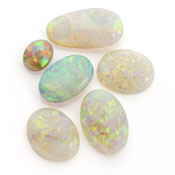Opal
(oh-puh l)
HISTORY and LORE
- Prized by Western cultures since Roman times, but opal’s history and geography extend much further. In Kenya anthropologists have found opal artifacts 6,000 years old, and 500 years ago the Aztecs mined opal in Central America.
- Name probably comes from Sanskrit upala meaning gem or jewel.
- Traditionally considered the most magic of gems because it shows the colors of all others combined. According to Middle Eastern folklore, opals and their flashing colors are born from lightning. In Europe, opal has long symbolized purity and hope.
- The superstition that opal is unlucky was spread by the novel Anne of Gerstein, written by Sir Walter Scott around 1830. The central character died after her opal lost its color.
- Birthstone for October and gem for the 14th wedding anniversary.
VALUE FACTORS
- Phenomenon: Displays dancing flashes of rainbow hues. This effect is known as play-of-color. In fine quality individual colors are bright, and form an attractive pattern that covers the gem. Not all opals display this phenomenon.
- Color: Full range includes white, gray, black, red, orange, yellow, and brown.
- Clarity: Usually translucent or opaque, but sometimes transparent.
- Cut: Cabochons of various shapes are most common. Fire opal is often faceted. All types are sometimes fashioned into carvings and beads
- Carat Weight: Most types are normally available in all jewelry sizes (up to 15 or 20 carats).
OPAL TYPES
Dealers and specialists identify dozens of different kinds of opal, but four are most important in jewelry:
- White opal – translucent to opaque white or light gray with play-of-color. This is the most popular type.
- Black opal – Translucent to opaque with play-of-color on a base of black or some other dark color. In finest quality, this is the rarest and costliest type.
- Crystal opal – Transparent with play-of-color on a colorless to dark gray base.
- Fire opal – Transparent to translucent red, orange, yellow, or brown. May or may not show play-of-color.
TREATMENT
White and black opals are often treated. Impregnation with oil, plastic, or wax conceals fractures and improves play-of-color. Dyeing can imitate the appearance of black opal and also heighten color play. Plastic treatment’s effects are usually permanent, and it creates no special care requirements for gem owners. Oil, was, and some dyes eventually deteriorate. Oil – or was-treated opal should not be exposed to intense light or even mild heat – like direct sun – for very long.
GEMOLOGY
- Classified as a mineral species composed primarily of silicon and oxygen (SiO2) with water. Water accounts for up to 10% of weight in most opals.
- Play-of-color occurs because opal has a unique structure. It’s made of minute spheres that break up white light into spectral hues. To create the phenomenon, the spheres must measure between 4 and 8 millionths of an inch in diameter; they must be the same size; and they must be stacked in a perfectly aligned grid pattern.
- Thin pieces of white and black opal are often assembled into opal doublets or triplets. In a doublet, the opal is cemented to a backing of stronger material such as chalcedony, glass, or plastic. In a triplet, the opal and backing are covered with a protective tip made from a colorless material like glass, quartz, or synthetic spinel.
CARE
Opal needs gentle wear and care. Protective setting recommended.
- Hardness: Moderate scratch resistance. Rates 5 to 6.5 on the Mohs Hardness Scale.
- Toughness: Fair to low resistance to chipping and breaking.
- Stability: May develop hairline fractures as a result of water loss from age or exposure to dry conditions or intense light.
- Cleaning: Detergent and water. Liquid cleaner is usually safe, except for oil- or wax-impregnated material. NEVER USE AN ULTRASONIC.
